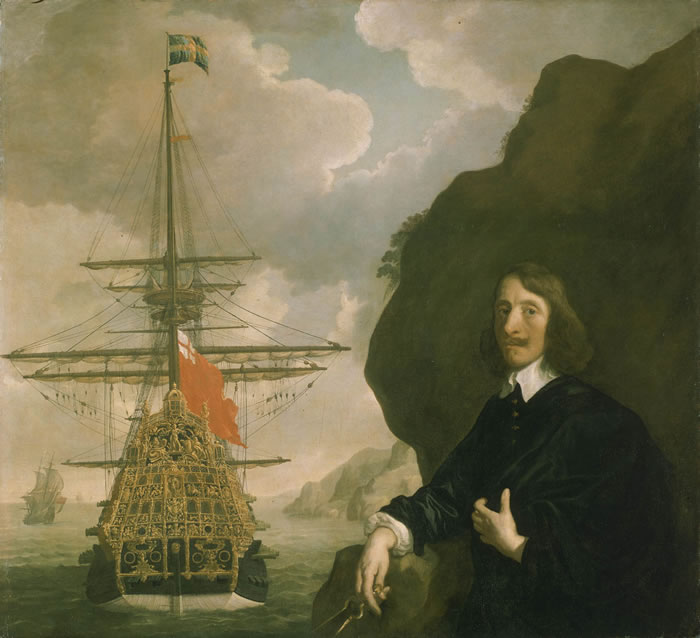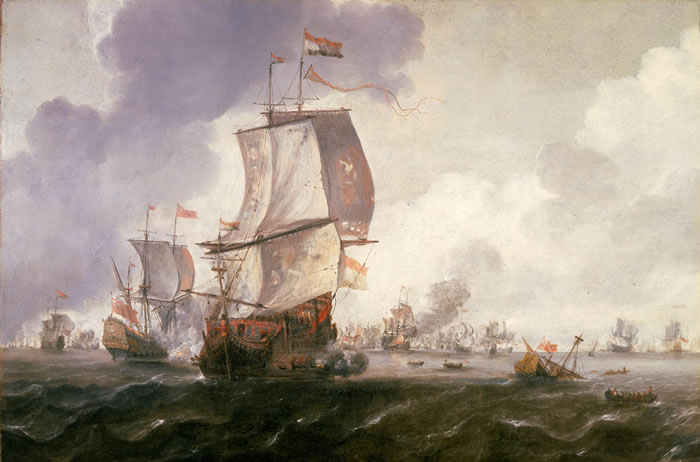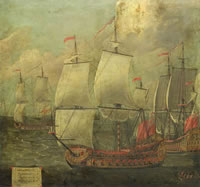|
The British Royal Navy
|
|
An
English Ship in Action with Barbary Ships, circa 1680 |
Money... The root
of all _______.
Not one of us
would call ourselves strangers to the concept of corporate and
government embezzlement and/or corruption. The first 15 or so years
after the death of Elizabeth I dealt out some of the most shameful and
debilitating blows to what had been an otherwise promising future for
the country's seafaring potential.
On a competence/leadership level, the unfortunate practice of 'buying' one's commission was already in full swing. This had occurred in the past, but it seemed to be that, at this time, those in power were not even that concerned with even maintaining an illusion of competency.
Then of
course, there were the financial and inefficiency woes. Here are just a
few ways that greed and corruption parasitically weakened the Navy:
- Imaginary offices created to which wages were sent, but siphoned off
to those in power
- Suppliers would make deals with purchasers, selling supplies at 2 or
more times the cost
- Shipyard officials slipping out with valuable building materials,
reselling them elsewhere
- Lumber used on actual shipbuilding was low quality, with the prime
pieces having been resold to other industries
Ships were often built so poorly that they'd be nearly useless after short periods of time and sailors, well, they were treated with less regard than even model ships - in a way. Pay was pathetic. Disabilities and losses were rarely paid to the sailors and their families - making the choice of a life at sea one of the least desirable one could image.
Cardinal
Richelieu and the Threat from France
I would not do
well without at least mentioning Cardinal Richelieu's role at the time
as an indirect catalyst in the development of the British Navy. Just as
I have stated in my Musketeer-orientated pages, Richelieu was played the
most important role in the of power in France, and not necessarily a
villain as he has been portrayed in many Musketeer movies. As a man of
great ambition, and a man who had command of a great deal of the French
Crown's money, he effectively created a new navy for France in a very
short period of time. By 1631, he had increased France's fleet of ships
to include nearly 40 200+ ton ships while England possessed under 30 of
such size.
_______________________________________
Sovereign of the Seas
Sovereign flagship of 17th century England
The early Stuarts were negligent in the arena of England's naval power. Whereas the Tudors had been stewards, the Stuarts, at least in the beginning of the 17th century, did so much damage to England's naval status that it is a wonder they would ever rival their European counterparts.
Sadly, the most beautiful and powerful ship to emerge from these years, commissioned by Charles I, was more of a showpiece than anything else - and on top of that - would live a heinously short life. She was the Sovereign of the Seas, the first true three-decker ship, and her cost was a lofty 40,000 pounds (reflect if you will, that the annual charge for the navy had been 50,000 pounds a year between 1610-1618). Her designer had a bit of a questionable history too: Peter Pett designed the ship along with his father, Phineas Pett. Phineas was a throw back to the days of corruption in the navy of Elizabeth I. Despite reports of Phineas' intent to defraud the crown and shoddy workmanship even during the reign of Gloriana - he was retained in service of the crown even well into the 1600s.
|
|
The beauty, her myth-based carvings gilded strictly in black and gold and her bronze cast guns, were a sign of the vanity of the monarchy and Charles I. Which is not to say she wasn't also reputed to be a fine vessel. She survived into the Commonwealth where she was renamed the Sovereign and then even into the reign of Charles II. Charles II rebuilt her in 1660 and bestowed yet another name change: Royal Sovereign. During this time, the huge vessel (carrying 102 guns - large for her time) saw action in a number of battles -including all three of the Anglo-Dutch Wars.
The saddest part of the Sovereign is the fact that she no longer exists - not because of lack of a preservation society - but because of careless human error. After 60 years of sailing, she was burned to her hull because of an accident.
_______________________________________
|
The Royal Navy & the English Civil War Somewhat ironically, one of the litany of reasons that are cited as causes of the English Civil War was Charles I's 1635 change of Ship Money policy. Ship Money was a payment made by coastal towns to provide for funding of the naval forces. Charles I felt that since the Navy was employed to protect the nation as a whole, and not just the coastlines, that the entire country should pay for the upkeep of the force. As logical as this sounds, two things worked against Charles I. First was his stubborn refusal to seek the approval of Parliament. Charles I was a devout proponent of the "Divine Right of Kings" and did not feel he needed to go through such measures. Also, he infuriated some of the wealthier lords of the land whom did not want this tax burden: They had not paid it before and they did not care to pay it at any point. |
|
[More to come]
_______________________________________
Cromwell and his Influence
Cromwell, the Commonwealth, and the Challenge.
As if usurping a monarchy and establishing a new government were not
enough, when Cromwell and Parliament assumed power in England - they had
inherited what could easily be seen as more daunting challenges ahead. With the
leading powers of France and Spain sympathetic to the ousted monarchy, and
with scarcely a fleet to their name (there had only been a fleet of 35
in 1642, at the onset of the civil war) - one of the first things on the
agenda was to get a force going on the waters.
Another exciting sign of the times? It was during the upcoming years that the adoption of the 'broadsides' would emerge. The name itself is nearly self-explanatory: Ships were now beginning to dish out (and receive) heavy punishment as they passed each other, broad-side to broad-side. Because of this ability, ships often lined up in rows across from enemy ships. (Now does "Ships of the Line" make sense?).
_______________________________________
1652:
The 'Infamous' Articles of War
Ah, the Articles
of War. Though intended to enforce discipline on crews and preserve the
safety and command of officers, you'll most often see these referred to
in movies like "Mutiny on the Bounty" or any other place where
they are abused in the hands of a tyrannical captain. Which is not to
say that they weren't pretty intimidating. Any list of offenses and
punishments which feature the word 'death' so prominently doesn't
exactly leave one feeling relaxed.
To clarify, the Articles of War were actually not backed by the law until 1661. Offenses named at that time included items such sleeping on watch, theft, striking a superior officer and desertion. Even at their inception, the rules frequently named death as a punishment. The lash was the preferred method of dealing with most crimes, and though discipline was formalized, it was rare that matters went so far as to be brought back to land for resolution.
The
Anglo-Dutch Wars
One thing that can certainly not be taken for granted in the role of
the development of the Royal Navy, not to mention the history of the 17th
century in general, were the Anglo-Dutch Wars. Trade was of penultimate
importance to all of Europe - and England was no exception, despite Her
own internal troubles. Clashes over vital trades of the times, such
as the slave trade and fishing rights in areas such as the North Sea
erupted regularly - and never so violently as they did between the Dutch
and the English.
England, being an island nation, asserted that she owned a large share of all trade to be done. To reinforce this belief, in 1651, Parliament passed the Navigation Act which stated that only English ships or those coming directly from their home country could import their goods to England and/or her colonies. The same went for ships transporting colonial exports.
|
|
Not
surprisingly, the Dutch were infuriated by what they perceived as
such arrogance (the Dutch adhered, at least publicly, that the seas
should remain free to all nations). It only took until 1652 for both
sides to amass fleets and for the bells of war to toll.
The first phase of the war (1652-4) was to last three years- under the command of the English Commonwealth. During this phase of the war, battles were scattered widely along the southern coast of England with the farthest East of them being located on the coast near Amsterdam. |
The second phase 1664-7of the wars focused more intently on the ports of slave trade and included battles off the coast of Africa. It was during this series of conflicts that the "Four Days' War" led to the destruction of 25 English ships.
The few years between the second and third phases of the Anglo-Dutch Wars would see these fierce territorial battles over the ocean subside for a brief hiatus: The English and Dutch would find common ground in the Protestant faith - against the French.
The final phase of the war 1672-4 was one in which odd 'bed-fellows' were made - in the form of an alliance between the French and the English against the still powerful Netherlands. And we all know how long THAT uneasy peace would last.... Even if the English people had liked the idea of being allied with the Catholic nation, the sheer power of these two constant rivals would inevitably give way. [MORE TO COME]
_______________________________________
The Restoration Era -
For Charles II and England's Navy
|
|
The
Ships Though known to be fond of the French in many ways, such as in culture and art, Charles II also drove through some of the most frenetic production of ships under the threat of that country's exponentially growing naval force. Building on what the Commonwealth had begun, the restored Stuart began to increase development of many new and many bigger, stronger ships. The most 'useful' ship in this new Navy were the third-rates; a double decked vessel sporting 56-70 guns. These third-rate frigates may not have been the largest, but they could move quickly and were not restricted to use in warmer months. |
The
Sailors
Peacetime didn't present much of a problem for England's Restoration
Navy. Wages were decent (though the perception was not always as such),
and communities where sea-related industries were standard fare usually
produced enough men willing to go into service. Wartime, however, was a
different matter. It was here where the 'press-gangs' took precedence,
conscripting men into service.
Certainly service in the Navy for the general sailor was no cake walk, but it was considerably better than it had been earlier in the century. Compensation for sailors and/or their families in the event of disability or death went through some formalization. War time pay was also relatively higher compared to the past, though it did not solve the problem of recruitment well enough to prevent the need for impressment (a.k.a. conscription).
The
Officers
Where did they come from? While the Commonwealth tried to adhere
to the usage of professional/career seamen to fill the roles of
officers, the monarchy preferred to use men of the nobility as a way to
ensure loyalty. To combat the possibility that the Navy would suffer
from an influx of completely incompetent officers, a few new reforms
appeared which pertained to testing and training. There was a new commitment
to ensuring that midshipmen would generally receive training - but the
'crowning glory' to the new system was Samuel Pepys' development of a
formalized test for the post of Lieutenant.
What motivated them? While it was certainly a way to gain station
in the service of the king, naval posts were generally not sought by men
who were primarily motivated by money.
While there was a chance for prize money and recognition during
war-time, the pay was pretty sub-par.
A progressive move for the rights of officers that did occur during this
time was the introduction of half-pay for officers during
peacetime.
_______________________________________
Links to various sites on these (and other) captivating ages of sail:
Royal Navy: Historical Periods A subsection of the official site for the British Royal Navy which gives a clear and concise overview of the Royal Navy's evolution
National Maritime Museum - The National Maritime Museum, based in London, has a surprising number of items online (try over 8500, of which 6500 have visuals!).Includes an excellent maritime art collection! All of the images on this page link to their site so that you may order prints!
Maritime Art: Greenwich - As referenced above, this site is an absolute glory! A breathtaking collection of maritime art presented with various search formats - with prints available!!!
Maritime History Home Page - Serves as an index to a number of sources across the Internet.
The Portsmouth Historic Dockyard - While two of their main attraction ships, the Mary Rose and the Victory, cradle the bulk of the period of time most of my site covers, this site has treasures a plenty.
Napoleonic Guide - A great reference site for Napoleonic Era militaria.
_______________________________________
Below: Two paintings based on the sailing age and her Admiral most often immortalized in popular culture: The Napoleonic era and Admiral Horatio Nelson. Nothing makes the draw of that period more clear than the continued popularity of series' such as C.S. Forester's Hornblower series and Patrick O'Brian's Jack Aubrey novels. While these events which these books are based on did not take place until a good century after the time-frames of my "Cavalier" focus - one can't mention the topic of the British Royal Navy without paying homage.
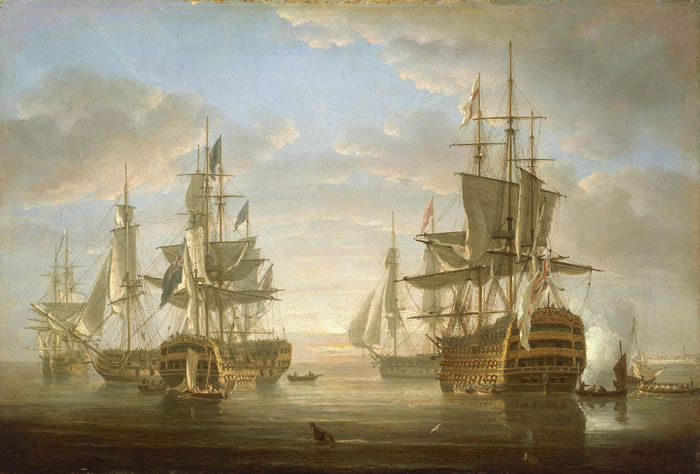 Nelson's Flagships at Anchor Artist Nicholas Pocock Date 1807 (Please click above for more information on art) |
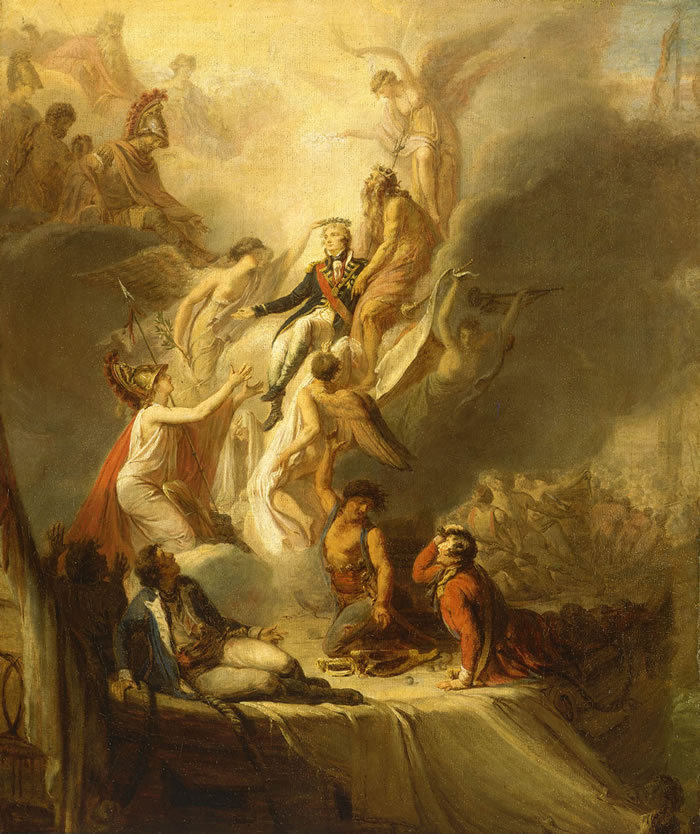 Apotheosis of Nelson Artist Scott Pierre Nicolas Legrand Date circa 1805-18 (Please click above for more information on art) |



